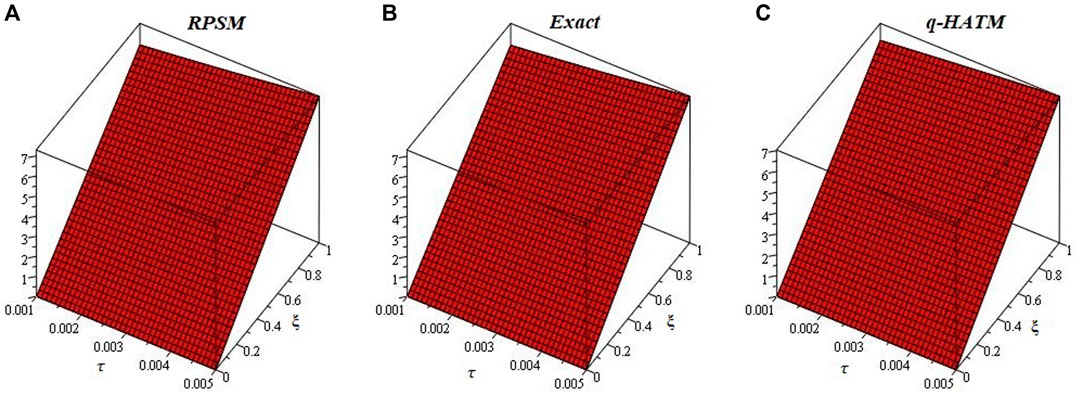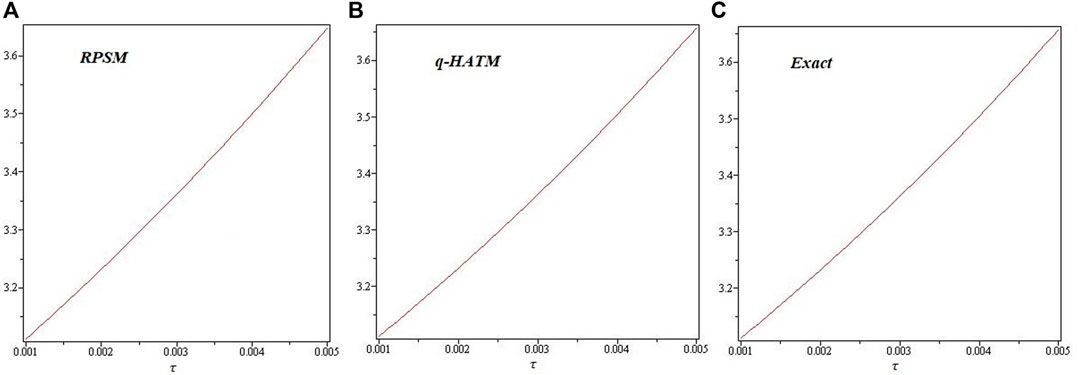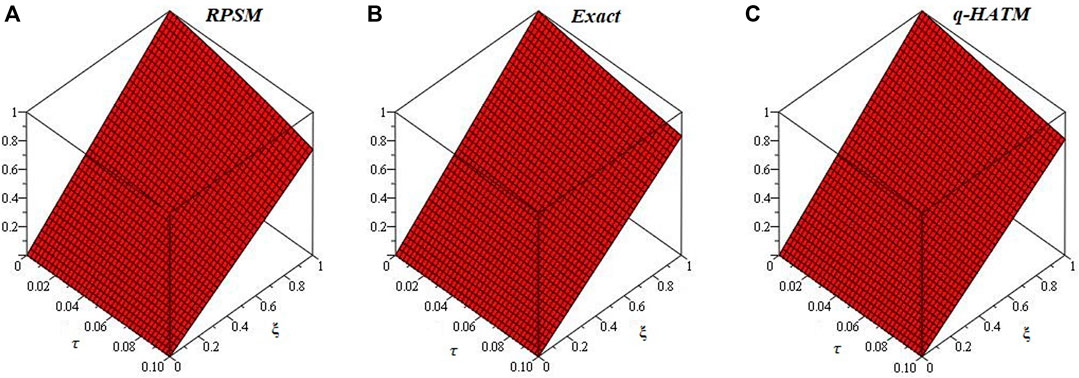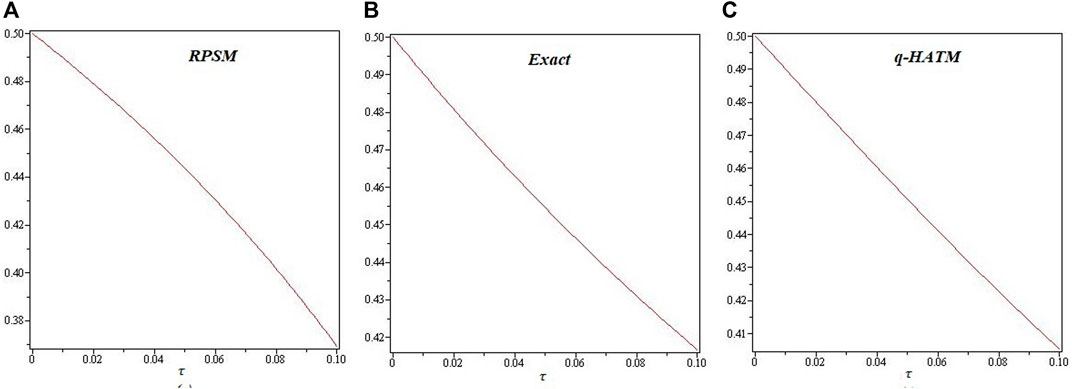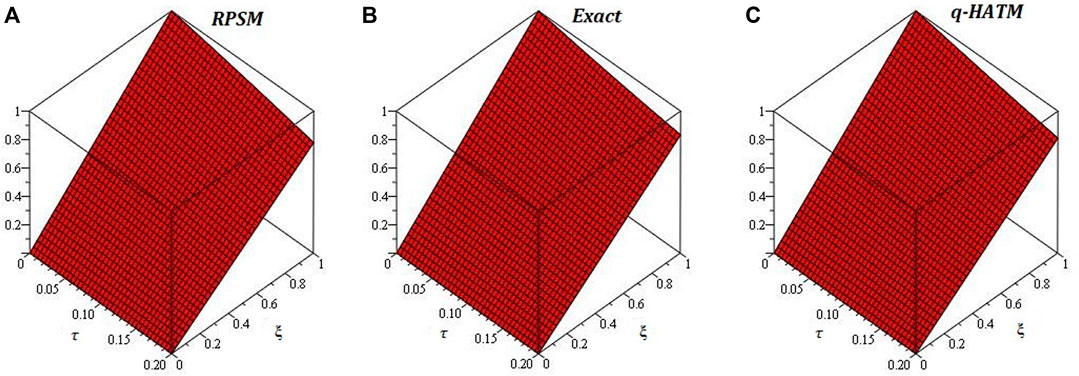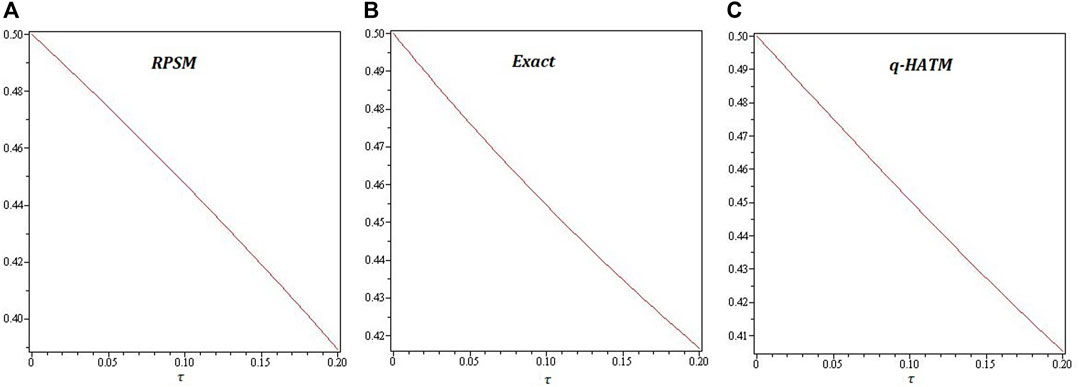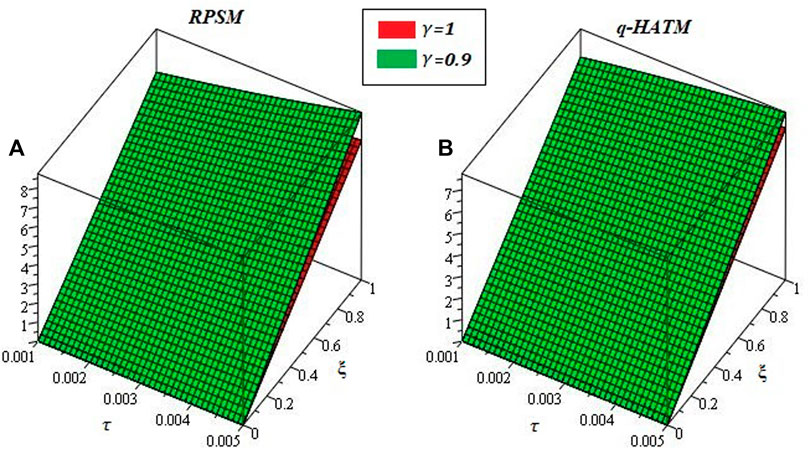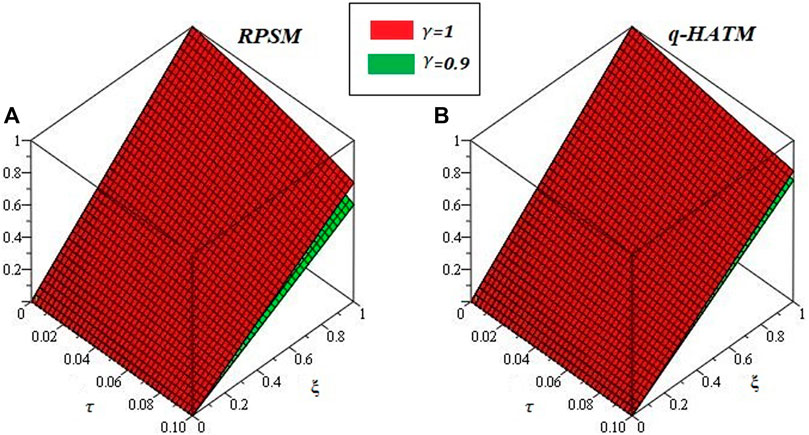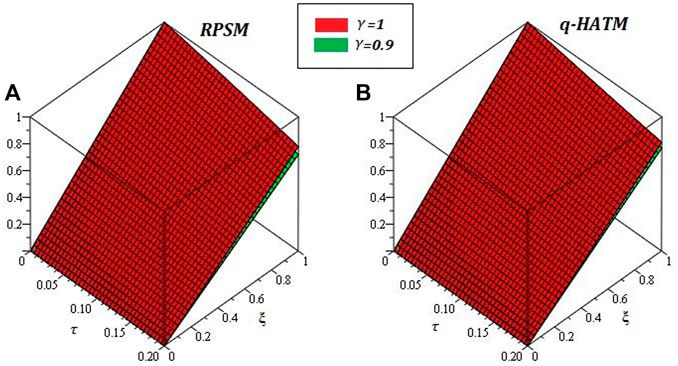- 1Department of Mathematics, Abdul Wali Khan Uniuersity Mardan, Mardan, Pakistan
- 2Department of Mathematics, Near East University, North Nicosia, Turkey
- 3Department of Mathematics, College of Science, King Saud University, Riyadh, Saudi Arabia
- 4School of Mathematical Sciences, Dublin City University, Dublin, Ireland
- 5Department of Medical Research, China Medical University Hospital, China Medical University, Taichung, Taiwan
- 6Theoretical and Computational Science (TaCS) Center, Department of Mathematics, Faculty of Science, King Mongkut’s University of Technology Thonburi (KMUTT), Bangkok, Thailand
- 7Intelligent and Nonlinear Dynamic Innovations Research Center, Department of Mathematics, Faculty of Applied Science, King Mongkut’s University of Technology North Bangkok (KMUTNB), Bangkok, Thailand
The solutions to fractional differentials equations are very difficult to investigate. In particular, the solutions of fractional partial differential equations are challenging tasks for mathematicians. In the present article, an extension to this idea is presented to obtain the solutions of non-linear fractional Korteweg–de Vries equations. The solutions comparison of the proposed problems is done via two analytical procedures, which are known as the Residual power series method (RPSM) and q-HATM, respectively. The graphical and tabular analysis are presented to show the reliability and competency of the suggested techniques. The comparison has shown the greater contact between exact, RPSM, and q-HATM solutions. The fractional solutions are in good control and provide many important dynamics of the given problems.
1 Introduction
Fractional Calculus literature dates back to 1,695 and considered to be as old as classical calculus. L’Hospital was the first to write a letter to Leibnitz about the concept of the time-fractional derivative, and progress in that direction has been gradual since that time. Later on N. H. Abel, L. Euler, J. Liouvilles, H. Holmgren, J. B. J. Fourier, A. K. Gruwald, P. S. Laplace, B. Riemann, E. R. Love, A. V. Letnikov, A. Krug, J. Hadamard, S. Pincherle, H. Weyl, O. Heaviside are among the few Nobel laureates in mathematics till the 20th century. Other Mathematicians such as H. Laurent, G.H. Hardy, and J. E. Liitlewood, as well as P. Levy, A. Marchand, H. T. Davis, A. Zygmund, A. Erde’lyi, H. Kober, D. V. widder, and M. Riesz, have contributed a lot towards FC. After 1930, there was infrequent additional research in this subject.
FC is a substitute calculus that may be used to appropriately design a variety of phenomena such as Optics [1], Hepatitis B Virus [3], Tuberculosis [4], Air foil [5], modelling of Earth quack nonlinear oscillation [6], Propagation of Spherical Waves [7], the fluid traffic [8], Chaos theory [9], Finance [11], economics [12], Zener [10], Cancer chemotherapy [13], Electrodynamics [14], heat transfer model [15], the fractional nonlinear space-time nuclear model [16], traffic flow model [17], Poisson-NerstPlanck diffusion [18], Pine wilt disease [19], Diabetes [20], fractional COVID-19 Model [2], biomedical and biological [21] and other applications in various branches of research [22–24]. Fractional differential and integral equations have been found to be the most desired tools for appropriately designing numerous physical processes. The polymers model with rheological characteristics, is the most important design that has been represented by FDEs. some others advanced development of FDEs includes bio tissues, nuclear mechanics, ractional diffusion, involuntary vibrations and thermo-elasticity [25–31].
Many mathematicians have made their efforts to develop or implement numerical and analytical techniques for the solutions of non-linear fractional partial differential equations (FPDEs). In this context, Hassan et al. have presented the solutions of some non-linear FPDEs and their systems in [32–35]. Many Other important and efficient techniques that have been implemented to solve FPDEs and their systems are Iterative Laplace transform method [38], optimal homotopy asymptotic method (OHAM) [39], extended direct algebraic method (EDAM) [49], Adomian decomposition method (ADM) [40, 41], Natural transform method [42], the Finite difference method (FDM) [43], the (G/Ǵ)-expansion method [48], the Homotopy perturbation transform technique along with transformation (HPTM) [44, 45, 47], standard reductive perturbation method [50], the Haar wavelet method (HWM) [51, 52], spectral collocation method (SCM) [46], the Variational iteration procedure with transformation (VITM) [58] and the differential transform method (DTM) [53–55]. In similar way, the novel techniques have been used for the solutions of Korteweg–de Vries equation and time-fractional Drinfeld–Sokolov–Wilson system and can be cited in [56, 57].
In this article, We are working with two efficient techniques, namely residual power series method (RPSM) and q-homotopy analysis transform method (q-HATM) to obtain the analytical solutions of Korteweg–de Vries equation (KdV) equations. The goal of the present research is to use q-HATM and RPSM to visualise the solutions to the KdV equations. The RPSM has a simple and fluent implementation in both strongly linear and nonlinear IVPs. RPSM [59] is used to construct power series solutions with the exception of perturbation and linearization. For an approximate analytical solution, the suggested approach uses a polynomial. The suggested approach is dominant over the Taylor series method because it allows to control large-scale computing. RPSM is used for systematically investigating the coefficients of a series form solutions. A fundamental advantage of RPSM is that it can be applied to other FPDEs and system of FPDEs. Another method which is known as q-HATM [36, 37] is the result of combining HAM and LTM when
In this research paper, the solutions of various FPDEs related to KdV equations are investigated by using the proposed analytical techniques, q-HAM and RPSM, at the same time. The suggested techniques have different procedure to obtain the solutions of fractional KdV equations. The obtained results of the two innovative techniques are compared to one another as well as with the exact solutions to the problems. The obtained results are displayed by using graphs and tables. The absolute errors at different fractional order are calculated and have shown the greater accuracy of the proposed methods. The RPSM procedure is simple and has a direct implementation to the targeted problems. Moreover, the linearity of the problems is handled in a very sophisticated manner as compare to other analytical procedures. The exact and approximate solutions for both techniques are very closed to the exact solutions of the given KdV equations. The fractional solutions are very convergent towards the integer order solutions and obey the higher efficiency of the present techniques. This paper is structured as follows: Section 2 represent some basic definition. Section 3 is the methodology while in Section 4 some numerical results are compared by using two powerful methods. Section 5 is the conclusion section. References are present at the end of the paper.
2 Basic Definitions
In this section we will discuss some important definitions.
2.1 Caputo Operator
For function
2.2 Definition
An expansion of power series (PS) at point
Note: FPS can be expanded at point
which is the Taylor’s series expansion form.
2.3 Laplace Transform
The LT for continuous function
here G(s) is the LT for the function
2.4 Definition
The LT
3 Methodology of RPSM and q-HATM for FPDEs
Consider a generalized non-linear FPDEs,
with initial condition,
where
3.1 RPSM Procedure
The procedure of RPSM [64] for the solution of Eq. 2 is given below.
Let
the kth truncated series for
for k = 0 Eq. 5, become as
further Eq. 5, implies that,
for Eq. 2, residual function is presented as
so, the kth residual function becomes
As in [65, 66], it show that
To calculate f1(ς), f2(ς), f3(ς), …, we put k = 0, 1, … , in Eq. 5, and putting in Eq. 7, after that we take
3.2 q-HATM Procedure
Applying LT to Eq. 2 and using the property, we obtained
The non-linear operator is given by
the real function of ς,
In Eq. 14
As for q = 0 and
By using Taylor theorem
where
As a consequence, we obtain the following result
In Eq. 14, zeroth order solution, which can be obtained by differentiating m-times and setting q = 0, implies that
In Eq. 19 the vectors are defined as
By taking inverse LT of Eq. 19, we get
as
and
The q-HATM series solution to the given problem is Eqs 20, 21.
4 Numerical Results
We used RPSM and q-HATM to solve the nonlinear KDV equation in this part.
4.1 Example
Consider the fractional order KDV equation of the form [68].
with initial condition,
the exact solution of the Eq. 22, is
4.1.1 RPSM-Solution
First Approximation.
Using RPSM, we get the Kth truncated series of the solution of Eq. 29.
The Eq. 23, can be represent as
set k = 1 in Eq. 24, we obtain
where y (ς, 0) = f(ς) = 6ς
The residual function of Eq. 22, is given by
The K − th residual function
put k = 1 in the Eq. 25 we get
put Resy1 (ς, 0) = 0 in Eq. 26, we get
Second approximation.
Put k = 2 in Eq. 24, we get
where f(ς) = 6ς, and f1(ς) = 216ς,
put k = 2 in Eq. 25, we get
we know that
put k = 2 in the Eq. 28, we get
Applying
put
Third approximation.
Put k = 3 in Eq. 24, we get
where f(ς) = 6ς, f1(ς) = 216ς, and f2(ς) = 15552ς,
put k = 2 in Eq. 25, we get
put k = 3 in Eq. 28, we get
Applying
put
In terms of RPSM, the solution of Eq. 29 is as follows:
4.1.2 q-HATM Solution
First Approximation.
Taking LT of Eq. 22, and simplifying
N is a nonlinear term that can be expressed as
Using the q-HATM approach
take m = 1 in Eq. 32, we obtain
use m = 1 in Eq. 34, we obtain
Put in Eq. 33, we get
Second Approximation
Put m = 2 in the Eq. 32, we get
put m = 2 in Eq. 34, we get
Put in Eq. 35, we get
Third Approximation
Put m = 3 in the Eq. 32, we get
put m = 3 in Eq. 34, we get
put in Eq. 36 and simplifying we get
In terms of q-HATM, the solution of Eq. 22 is shown as
4.2 Example
The fractional order K (2,2) equation is [68].
having initial condition
Exact solution is
4.2.1 RPSM-Solution
First Approximation.Using RPSM, we get the Kth truncated series of the solution of Eq. 37
Equation 37 has a zeroth RPSM approximate solution, which is
Equation 38 can be represent as
for k = 1 Eq. 39, become
where y (ς, 0) = f(ς) = ς
the residual function of Eq. 37, is given by
the Kth residual function
put k = 1 in the Eq. 40, we get
we know that
Second approximation
Put k = 2 in Eq. 39, we get
where f(ς) = ς, and f1(ς) = −2ς
put k = 2 in Eq. 40, we get
we know that
put k = 2 in Eq. 44
applying
put
Third approximation
Put k = 3 in Eq. 39, we get
where f(ς) = ς, f1(ς) = −2ς and f2(ς) = −8ς
put k = 2 in Eq. 40, we get
put k = 3 in Eq. 44, we get
applying
put
The RPSM solution of Eq. 37, is given as
4.2.2 q-HATM Solution
First Approximation.
Taking LT of Eq. 37, and simplifying
N is the nonlinear term and is defined as
Using the procedure of q-HATM
for m = 1 Eq. 48, become
for m = 1 Eq. 50, become
Put in Eq. 49, we get
Second Approximation
Put m = 2 in Eq. 48, we obtain
set m = 2 in Eq. 50, we have
Put in Eq. 51, we get
Third Approximationfor m = 3 Eq. 48, become as
as for m = 3 Eq. 50, become as
put in Eq. 52, and simplifying
The q-HATM solution of Eq. 37 is given as
4.3 Example
The fractional order KDV equation of the form [68].
the initial condition of Eq. 53, is
The exact solution of the Eq. 53, is
4.3.1 RPSM-Solution
First Approximation.
The Kth truncated series of the solution of Eq. 53, using RPSM we get
the zeroth RPSM approximate solution of Eq. 53, is
so the Eq. 54, should be written as
put k = 1 in Eq. 55, we have
where y (ς, 0) = f(ς) = ς,
the residual function of Eq. 53, is given by
the Kth residual function
put k = 1 in the Eq. 56 we get
we know that
put in Eq. 57, we get
Second approximation
Put k = 2 in Eq. 55, we get
where f(ς) = ς, and f1(ς) = −ς
put k = 2 in Eq. 56, we get
we know that
put k = 2 in Eq. 59, we get
applying
put
Third approximation
Put k = 3 in Eq. 55 we get
where f(ς) = ς, f1(ς) = −ς and f2(ς) = −ς
put k = 2 in Eq. 56, we get
put k = 3 in Eq. 59, we get
applying
put
put k = 2 in Eq. 56, we get
The RPSM solution of Eq. 53, is given as
4.3.2 q-HATM Solution
First Approximation.
Taking LT of Eq. 53, and simplifying
The nonlinear term N is defined as
Using the procedure of q-HATM
put m = 1 in the Eq. 63, we get
put m = 1 in Eq. 65, we get
put in Eq. 64, we get
Second Approximation
Put m = 2 in the Eq. 63, we get
Put m = 2 in the Eq. 65, we get
put in Eq. 66, we get
Third Approximation
Put m = 3 in the Eq. 63, we get
put m = 3 in the Eq. 65, we get
put in Eq. 67, and simplifying
The q-HATM solution of Eq. 53, is given as
5 Results and Discussions
Figures 1-6 are the 2D and 3D comparison plots of RPSM, q-HATM, and Exact-solutions of Example 4.1, 4.2, and 4.3 respectively for fractional-order δ = 1. Figures 7-9 are the 3D comparison of q-HATM and RPSM-solutions at fractional-order δ = 0.9, 1 for Example 4.1, 4.2, and 4.3 respectively. Tables 1–3 are the absolute error comparison of q-HATM and RPSM solutions for Example 4.1, 4.2, and 4.3 respectively. In the above Figures and tables, it is observed that the q-HATM, RPSM and exact solutions are in closed contact with each other at integer-order derivatives of each problem. The fractional order solutions are compared of the proposed techniques and provide the excellent agreement in their solutions by using q-HATM and RPSM techniques. It is analyzed through graphs and tables that the fractional solutions are convergent towards integer order solutions.
6 Conclusion
In this paper, the solutions of various non-linear fractional KdV equations are presented using two innovative techniques. RPSM and q-HATM are the most simple and straightforward procedures which can be used effectively for the solutions FPDEs and their systems. The obtained solutions, using the proposed techniques are displayed through graphs and tables. The solutions comparison has shown a very close contact between the exact, RPSM and q-HATM solutions of the targeted problems. The fractional-order solutions of higher interest and provide the useful information about the dynamics of the targeted problems. The fractional solutions are found convergent towards the actual solution of the targeted problems. The present work fully supports the actual dynamics of the physical phenomena and can be extended for the solutions of other complex and non-linear FPDEs and their systems.
Data Availability Statement
The original contributions presented in the study are included in the article/supplementary material, further inquiries can be directed to the corresponding author.
Author Contributions
HK (Supervision), QK (Methodology), FT (Project administrator), PK (Funding, Draft Writing), GS (Investigation), IU (Methodology), KS (Funding, Draft Writing), FT (Draft writing, visualization).
Funding
The authors acknowledge the financial support provided by the Center of Excellence in Theoretical and Computational Science (TaCS-CoE), KMUTT. This research project is supported by Thailand Science Research and Innovation (TSRI) Basic Research Fund: Fiscal year 2022 under project number FRB650048/0164. Researchers Supporting Project number (RSP2022R440), King Saud University, Riyadh, Saudi Arabia.
Conflict of Interest
The authors declare that the research was conducted in the absence of any commercial or financial relationships that could be construed as a potential conflict of interest.
Publisher’s Note
All claims expressed in this article are solely those of the authors and do not necessarily represent those of their affiliated organizations, or those of the publisher, the editors and the reviewers. Any product that may be evaluated in this article, or claim that may be made by its manufacturer, is not guaranteed or endorsed by the publisher.
References
1. Longhi S. Fractional Schrödinger Equation in Optics. Opt Lett (2015) 40(6):1117–20. doi:10.1364/ol.40.001117
2. Din A, Khan A, Zeb A, Sidi Ammi MR, Tilioua M, Torres DFM. Hybrid Method for Simulation of a Fractional COVID-19 Model with Real Case Application. Axioms (2021) 10(4):290. doi:10.3390/axioms10040290
3. Ullah S, Khan MA, Farooq M. A New Fractional Model for the Dynamics of the Hepatitis B Virus Using the Caputo-Fabrizio Derivative. The Eur Phys J Plus (2018) 133(6):1–14. doi:10.1140/epjp/i2018-12072-4
4. Altaf Khan M, Ullah S, Farooq M. A New Fractional Model for Tuberculosis with Relapse via Atangana-Baleanu Derivative. Chaos, Solitons & Fractals (2018) 116:227–38. doi:10.1016/j.chaos.2018.09.039
5. Mahmood S, Shah R, khan H, Arif M. Laplace Adomian Decomposition Method for Multi Dimensional Time Fractional Model of Navier-Stokes Equation. Symmetry (2019) 1111(22):149149. doi:10.3390/sym11020149
6. He JH. Nonlinear Oscillation with Fractional Derivative and its Applications. Int Conf vibrating Eng (1998) 98:288–91.
7. Fellah ZEA, Fellah M, Roncen R, Ongwen NO, Ogam E, Depollier C. Transient Propagation of Spherical Waves in Porous Material: Application of Fractional Calculus. Symmetry (2022) 14(2):233. doi:10.3390/sym14020233
8. He JH. Homotopy Perturbation Technique. Comput Methods Appl Mech Eng (1999) 178(3-4):257–62. doi:10.1016/s0045-7825(99)00018-3
9. Wu X, Lai D, Lu H. Generalized Synchronization of the Fractional-Order Chaos in Weighted Complex Dynamical Networks with Nonidentical Nodes. Nonlinear Dyn (2012) 69(1):667–83. doi:10.1007/s11071-011-0295-9
10. Birajdar GA. Numerical Solution of Time Fractional Navier-Stokes Equation by Discrete Adomian Decomposition Method. Nonlinear Eng (2014) 3(1):21–6. doi:10.1515/nleng-2012-0004
11. Momani S, Odibat Z. Analytical Solution of a Time-Fractional Navier-Stokes Equation by Adomian Decomposition Method. Appl Maths Comput (2006) 177(2):488–94. doi:10.1016/j.amc.2005.11.025
12. Tarasov V. On History of Mathematical Economics: Application of Fractional Calculus. Mathematics (2019) 7(6):509. doi:10.3390/math7060509
13. Veeresha P, Prakasha DG, Baskonus HM. New Numerical Surfaces to the Mathematical Model of Cancer Chemotherapy Effect in Caputo Fractional Derivatives. Chaos (2019) 29(1):013119. doi:10.1063/1.5074099
14. Nasrolahpour H. A Note on Fractional Electrodynamics. Commun Nonlinear Sci Numer Simulation (2013) 18(9):2589–93. doi:10.1016/j.cnsns.2013.01.005
15. Yang XJ, Abdel-Aty M, Cattani C. A New General Fractional-Order Derivataive with Rabotnov Fractional-Exponential Kernel Applied to Model the Anomalous Heat Transfer. Therm Sci (2019) 23(3 Part A):1677–81. doi:10.2298/tsci180320239y
16. Abdel-Aty A-H, Khater MMA, Attia RAM, Abdel-Aty M, Eleuch H. On the New Explicit Solutions of the Fractional Nonlinear Space-Time Nuclear Model. Fractals (2020) 28(08):2040035. doi:10.1142/s0218348x20400356
17. Kang Y, Mao S, Zhang Y. Fractional Time-Varying Grey Traffic Flow Model Based on Viscoelastic Fluid and its Application. Transportation Res B: methodological (2022) 157:149–74. doi:10.1016/j.trb.2022.01.007
18. Chaurasia VBL, Kumar D. Solution of the Time-Fractional Navier–Stokes Equation. Gen Math Notes (2011) 4(2):49–59.
19. Khan MA, Ullah S, Okosun KO, Shah K. A Fractional Order pine Wilt Disease Model with Caputo–Fabrizio Derivative. Adv Difference Equations (2018) 2018(1):1–18. doi:10.1186/s13662-018-1868-4
20. Singh J, Kumar D, Baleanu D. On the Analysis of Fractional Diabetes Model with Exponential Law. Adv Difference Equations (2018) 2018(1):1–15. doi:10.1186/s13662-018-1680-1
21. Bertsias P, Kapoulea S, Psychalinos C, Elwakil AS. A Collection of Interdisciplinary Applications of Fractional-Order Circuits. In: Fractional Order Systems. Cambridge, MA, USA: Academic Press (2022). p. 35–69. doi:10.1016/b978-0-12-824293-3.00007-7
23. Kilbas AA, Srivastava HM, Trujillo JJ. Theory and Applications of Fractional Differential Equations (Vol. 204). Amsterdam, Netherlands: Elsevier (2006).
24. Das S. A Note on Fractional Diffusion Equations. Chaos, Solitons & Fractals (2009) 42(4):2074–9. doi:10.1016/j.chaos.2009.03.163
25. Barbosa R, Tenreiro Machado JA, Ferreira IM. PID Controller Tuning Using Fractional Calculus Concepts. Fractional calculus Appl Anal (2004) 7:121–34.
26. Machado JA. Analysis and Design of Fractional-Order Digital Control Systems. SAMS (1997) 27:107–22.
27. Machado JA, Jesus IS, Cunha JB, Tar JK. Fractional Dynamics and Control of Distributed Parameter Systems. Intell Syst Serv Mankind (2004) 2014:295–305.
28. Kumar D, Singh J, Kumar S. Numerical Computation of Nonlinear Fractional Zakharov-Kuznetsov Equation Arising in Ion-Acoustic Waves. J Egypt Math Soc (2014) 22(3):373–8. doi:10.1016/j.joems.2013.11.004
29. Kumar R, Koundal R. Generalized Least Square Homotopy Perturbation for System FPDEs. arXiv preprint arXiv:1805.06650 (2018).
30. Demir A, Erman S, Özgür B, Korkmaz E. Analysis of Fractional Partial Differential Equations by Taylor Series Expansion. Bound Value Probl (2013) 2013(1):68. doi:10.1186/1687-2770-2013-68
31. Baleanu D, Tenerio Machado JA, Cattani c., Baleanu MC, Yang XJ. Local Fractional Variational Iteration and Decomposition Method for Wave Equation on Cantor Sets within Local Fractional Operators. Abstract Appl Anal (2013) 2014:535048. doi:10.1155/2014/535048
32. Khan H, Shah R, Kumam P, Baleanu D, Arif M. Laplace Decomposition for Solving Nonlinear System of Fractional Order Partial Differential Equations. Adv Difference Equations (2020) 2020(1):1–18. doi:10.1186/s13662-020-02839-y
33. Alderremy AA, Khan H, Shah R, Aly S, Baleanu D. The Analytical Analysis of Time-Fractional Fornberg-Whitham Equations. Mathematics (2020) 8(6):987. doi:10.3390/math8060987
34. Shah R, Khan H, Baleanu D, Kumam P, Arif M. A Novel Method for the Analytical Solution of Fractional Zakharov–Kuznetsov Equations. Adv Difference Equations (2019) 2019(1):1–14. doi:10.1186/s13662-019-2441-5
35. Srivastava HM, Shah R, Khan H, Arif M. Some Analytical and Numerical Investigation of a Family of Fractional‐order Helmholtz Equations in Two Space Dimensions. Math Meth Appl Sci (2020) 43(1):199–212. doi:10.1002/mma.5846
36. Prakash A, Kaur H. Numerical Solution for Fractional Model of Fokker-Planck Equation by Using Q-HATM. Chaos, Solitons & Fractals (2017) 105:99–110. doi:10.1016/j.chaos.2017.10.003
37. Singh J, Kumar D, Swroop R. Numerical Solution of Time- and Space-Fractional Coupled Burgers' Equations via Homotopy Algorithm. Alexandria Eng J (2016) 55:1753–63. doi:10.1016/j.aej.2016.03.028
38. Jafari H, Nazari M, Baleanu D, Khalique CM. A New Approach for Solving a System of Fractional Partial Differential Equations. Comput Maths Appl (2013) 66(5):838–43. doi:10.1016/j.camwa.2012.11.014
39. Mustahsan M, Younas HM, Iqbal S, Rathore S, Nisar KS, Singh J. An Efficient Analytical Technique for Time-Fractional Parabolic Partial Differential Equations. Front Phys (2020) 8:131. doi:10.3389/fphy.2020.00131
40. Wang Q. Numerical Solutions for Fractional KdV-Burgers Equation by Adomian Decomposition Method. Appl Maths Comput (2006) 182(2):1048–55. doi:10.1016/j.amc.2006.05.004
41. Daftardar-Gejji V, Bhalekar S. Solving Multi-Term Linear and Non-linear Diffusion-Wave Equations of Fractional Order by Adomian Decomposition Method. Appl Maths Comput (2008) 202(1):113–20. doi:10.1016/j.amc.2008.01.027
42. Ismail GM, Abdl-Rahim HR, Abdel-Aty A, Kharabsheh R, Alharbi W, Abdel-Aty M. An Analytical Solution for Fractional Oscillator in a Resisting Medium. Chaos, Solitons & Fractals (2020) 130:109395. doi:10.1016/j.chaos.2019.109395
43. Chamekh M, Elzaki TM. Explicit Solution for Some Generalized Fluids in Laminar Flow with Slip Boundary Conditions. J Math Comput Sci. (2018) 18:272–81. doi:10.22436/jmcs.018.03.03
44. Liu H, Khan H, Shah R, Alderremy AA, Aly S, Baleanu D. On the Fractional View Analysis of Keller–Segel Equations with Sensitivity Functions. Complexity (2020) 2020:2371019. doi:10.1155/2020/2371019
45. Abdulaziz O, Hashim I, Ismail ES. Approximate Analytical Solution to Fractional Modified KdV Equations. Math Comput Model (2009) 49(1-2):136–45. doi:10.1016/j.mcm.2008.01.005
46. Srivastava HM, Saad KM, Hamanah WM. Certain New Models of the Multi-Space Fractal-Fractional Kuramoto-Sivashinsky and Korteweg-De Vries Equations. Mathematics (2022) 10(7):1089. doi:10.3390/math10071089
47. Wang Q. Homotopy Perturbation Method for Fractional KdV Equation. Appl Maths Comput (2007) 190(2):1795–802. doi:10.1016/j.amc.2007.02.065
48. Ali KK, Dutta H, Yilmazer R, Noeiaghdam S. On the New Wave Behaviors of the Gilson-Pickering Equation. Front Phys (2020) 8:54. doi:10.3389/fphy.2020.00054
49. Korpinar Z, Tchier F, Inc M. On Optical Solitons of the Fractional (3+1)-Dimensional NLSE with Conformable Derivatives. Front Phys (2020) 8:87. doi:10.3389/fphy.2020.00087
50. Uddin MF, Hafez MG, Hwang I, Park C. Effect of Space Fractional Parameter on Nonlinear Ion Acoustic Shock Wave Excitation in an Unmagnetized Relativistic Plasma. Front Phys (2022) 2022:766. doi:10.3389/fphy.2021.766035
51. Rehman Mu., Khan RA. Numerical Solutions to Initial and Boundary Value Problems for Linear Fractional Partial Differential Equations. Appl Math Model (2013) 37(7):5233–44. doi:10.1016/j.apm.2012.10.045
52. Akinlar MA, Secer A, Bayram M. Numerical Solution of Fractional Benney Equation. Appl Math Inf Sci (2014) 8(4):1633–7. doi:10.12785/amis/080418
53. Secer A, Akinlar MA, Cevikel A. Similarity Solutions for Multiterm Time-Fractional Diffusion Equation. Adv Differ Equ (2012) 2012:7304659. doi:10.1155/2016/7304659
54. Kurulay M, Bayram M. Approximate Analytical Solution for the Fractional Modified KdV by Differential Transform Method. Commun nonlinear Sci Numer simulation (2010) 15(7):1777–82. doi:10.1016/j.cnsns.2009.07.014
55. Kurulay M, Akinlar MA, Ibragimov R. Computational Solution of a Fractional Integro-Differential Equation. Abstract Appl Anal (2013) 2013:865952. doi:10.1155/2013/865952
56. Srivastava HM, Saad KM. Some New and Modified Fractional Analysis of the Time-Fractional Drinfeld-Sokolov-Wilson System. Chaos (2020) 30(11):113104. doi:10.1063/5.0009646
57. Khader MM, Saad KM. Numerical Studies of the Fractional Korteweg-De Vries, Korteweg-De Vries-Burgers' and Burgers' Equations. Proc Natl Acad Sci India, Sect A Phys Sci (2021) 91(1):67–77. doi:10.1007/s40010-020-00656-2
58. Shah R, Khan H, Baleanu D, Kumam P, Arif M. A Semi-analytical Method to Solve Family of Kuramoto-Sivashinsky Equations. J Taibah Univ Sci (2020) 14(1):402–11. doi:10.1080/16583655.2020.1741920
59. Abu O. Arqub, Series Solution of Fuzzy Differential Equation under Strongly Generalized Differentiability. J Adv Res Appl Maths (2013) 5:31. doi:10.5373/jaram.1447.051912
61. Caputo M. Linear Models of Dissipation Whose Q Is Almost Frequency Independent--II. Geophys J Int (1967) 13:529–39. doi:10.1111/j.1365-246x.1967.tb02303.x
62. Miller KS, Ross B. An Introduction to the Fractional Calculus and Fractional Differential Equation. New York: Wiley (1993).
63. Tchier F, Inc M, Korpinar ZS, Baleanu D. Solution of the Time Fractional Reaction-Diffusion Equations with Residual Power Series Method. Adv Mech Eng (2016) 8:1–10. doi:10.1177/1687814016670867
64. Prakasha DG, Veeresha P, Baskonus HM. Residual Power Series Method for Fractional Swift-Hohenberg Equation. Fractal Fract (2019) 3(1):9. doi:10.3390/fractalfract3010009
65. Abu Arqub O. Series Solution of Fuzzy Differential Equations under Strongly Generalized Differentiability. J Adv Res Appl Maths (2013) 5(1):31–52. doi:10.5373/jaram.1447.051912
66. Abu Arqub O, El-Ajou A, Bataineh AS, Hashim I. A Representation of the Exact Solution of Generalized Lane-Emden Equations Using a New Analytical Method. Abstract Appl Anal (2013) 2013:378593. doi:10.1155/2013/378593
67. Prakash A, Kaur H. Q-Homotopy Analysis Transform Method for Space and Time-Fractional KdV-Burgers Equation. Nonlinear Sci Lett A (2018) 9(1):44–61.
Keywords: fractional calculus, Laplace transform, Laplace residual power series method, fractional partial differential equation, power series, q-homotopy analysis transform method
Citation: Khan H, Khan Q, Tchier F, Singh G, Kumam P, Ullah I, Sitthithakerngkiet K and Tawfiq F (2022) The Efficient Techniques for Non-Linear Fractional View Analysis of the KdV Equation. Front. Phys. 10:924310. doi: 10.3389/fphy.2022.924310
Received: 20 April 2022; Accepted: 13 June 2022;
Published: 25 July 2022.
Edited by:
Wenjun Liu, Nanjing University of Information Science and Technology, ChinaReviewed by:
Mahmoud Abdel-Aty, Sohag University, EgyptKhaled M. Saad, Najran University, Saudi Arabia
Copyright © 2022 Khan, Khan, Tchier, Singh, Kumam, Ullah, Sitthithakerngkiet and Tawfiq. This is an open-access article distributed under the terms of the Creative Commons Attribution License (CC BY). The use, distribution or reproduction in other forums is permitted, provided the original author(s) and the copyright owner(s) are credited and that the original publication in this journal is cited, in accordance with accepted academic practice. No use, distribution or reproduction is permitted which does not comply with these terms.
*Correspondence: Poom Kumam, cG9vbS5rdW1Aa211dHQuYWMudGg=
 Hassan Khan
Hassan Khan Qasim Khan
Qasim Khan Fairouz Tchier
Fairouz Tchier Gurpreet Singh4
Gurpreet Singh4 Poom Kumam
Poom Kumam